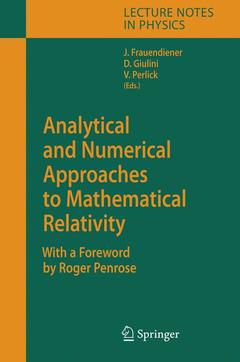Description
Analytical and Numerical Approaches to Mathematical Relativity, 2006
Lecture Notes in Physics Series, Vol. 692
Coordinators: Frauendiener Jörg, Giulini Domenico J. W., Perlick Volker
Prefaced by: Penrose Roger
Language: English
Analytical and Numerical Approaches to Mathematical Relativity
Publication date: 11-2010
281 p. · 15.5x23.5 cm · Paperback
Publication date: 11-2010
281 p. · 15.5x23.5 cm · Paperback
Analytical and numerical approaches to mathematical relativity, (Lecture notes in physics, Vol. 692)
Publication date: 03-2006
281 p. · 15.5x23.5 cm · Hardback
Publication date: 03-2006
281 p. · 15.5x23.5 cm · Hardback
Description
/li>Contents
/li>Comment
/li>
The general theory of relativity, as formulated by Albert Einstein in 1915, provided an astoundingly original perspective on the physical nature of gr- itation, showing that it could be understood as a feature of a curvature in the four-dimensional continuum of space-time. Now, some 90 years later, this extraordinary theory stands in superb agreement with observation, prov- ing a profound accord between the theory and the actual physical behavior of astronomical bodies, which sometimes attains a phenomenal precision (in one case to about one part in one hundred million million, where several d- ferent non-Newtonian e?ects, including the emission of gravitational waves, are convincingly con?rmed). Einstein?s tentative introduction, in 1917, of an additional term in his equations, speci?ed by a ?cosmological constant?, - pearsnowtobeobservationallydemanded,andwiththistermincluded,there is no discrepancy known between Einstein?s theory and classical dynamical behavior, from meteors to matter distributions at the largest cosmological scales. One of Einstein?s famous theoretical predictions that light is bent in a gravitational ?eld (which had been only roughly con?rmed by Eddington?s solareclipsemeasurementsattheIslandofPrincipein1919,butwhichisnow very well established) has become an important tool in observational cosm- ogy, where gravitational lensing now provides a unique and direct means of measuring the mass of very distant objects.
Differential Geometry and Differential Topology.- A Personal Perspective on Global Lorentzian Geometry.- The Space of Null Geodesics (and a New Causal Boundary).- Some Variational Problems in Semi-Riemannian Geometry.- On the Geometry of pp-Wave Type Spacetimes.- Analytical Methods and Differential Equations.- Concepts of Hyperbolicity and Relativistic Continuum Mechanics.- Elliptic Systems.- Mathematical Properties of Cosmological Models with Accelerated Expansion.- The Poincaré Structure and the Centre-of-Mass of Asymptotically Flat Spacetimes.- Numerical Methods.- Computer Simulation – a Tool for Mathematical Relativity – and Vice Versa.- On Boundary Conditions for the Einstein Equations.- Recent Analytical and Numerical Techniques Applied to the Einstein Equations.- Some Mathematical Problems in Numerical Relativity.
Reviews accurately tested fundeamental theory,
Includes surveys by experts in mathematical relativity
Includes differential geometry and differential topology, analytical methods and differential equations, and numerical methods
© 2024 LAVOISIER S.A.S.




